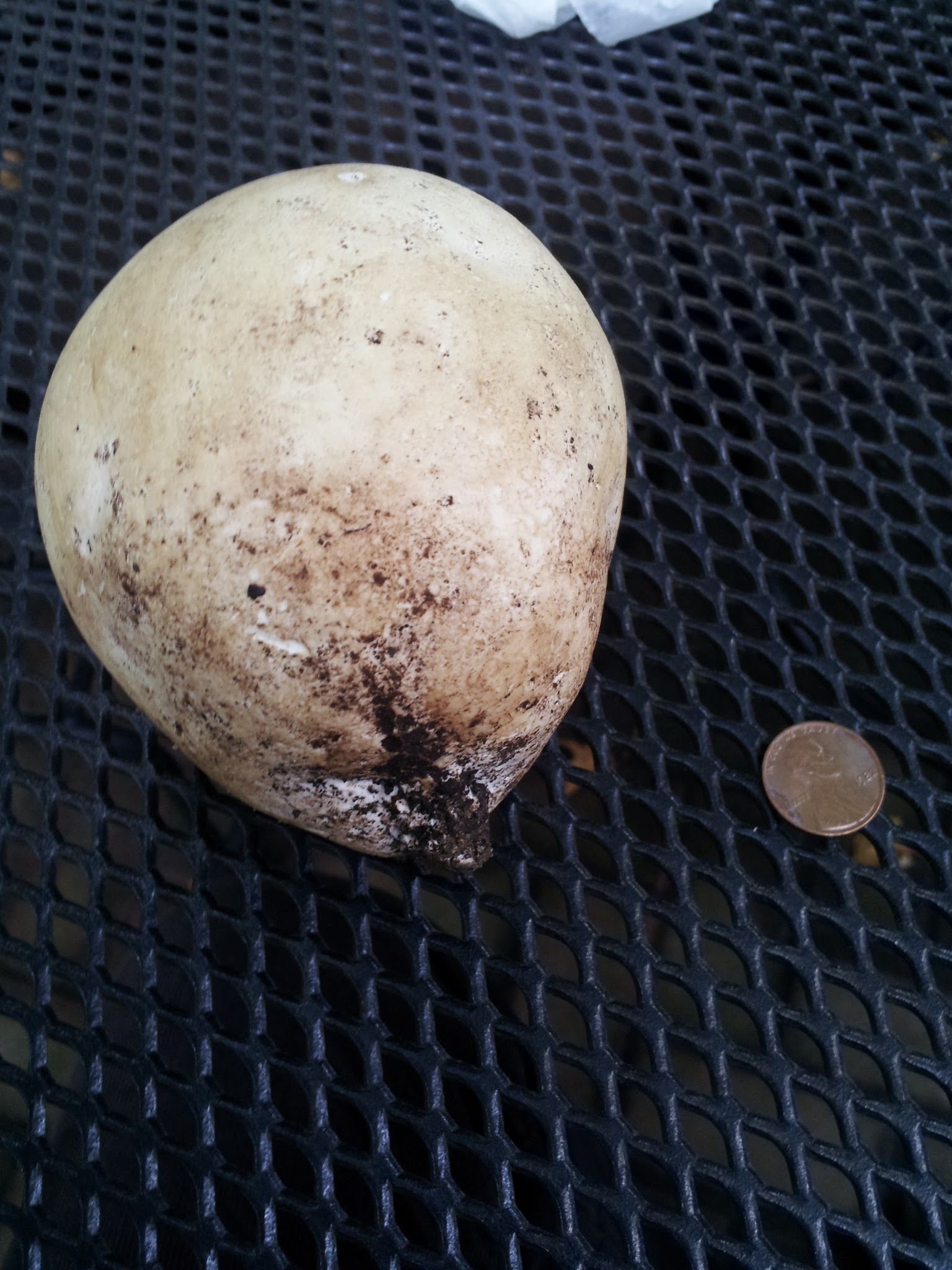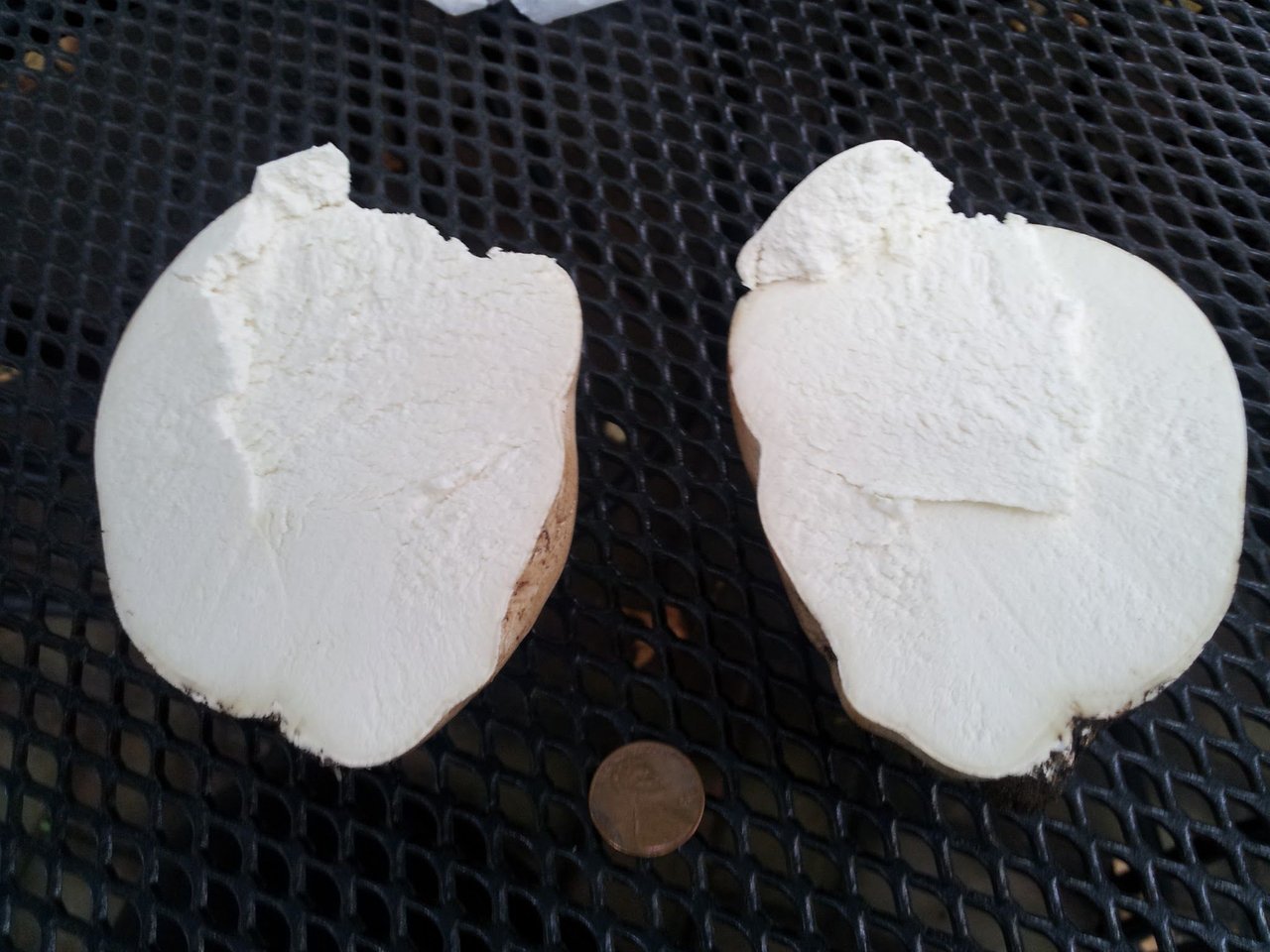
The first species specific post we did was of the common puffball, Lycoperdon perlatum. A couple of posts ago we talked about B.edulis and @foodisfree asked whether other mushrooms get bigger than the sometimes very large B.edulis and its cousins.
Well, @foodisfree, here's your answer. A mushroom like almost no other on earth - Calvatia gigantea - or the Giant Puffball.

Above is C.gigantea. These things can get positively enormous - ball shaped and over a meter in diameter, sometimes over 40 pounds each. There are stories of C.gigantea being mistaken for an errant sheep. C.gigantea pops up out of the earth, seemingly out of no where, often growing in grassy fields, or in deciduous forests, sometimes alone and sometimes in groups.

Like its relatively tiny cousins L.pyriform, all giant puffballs are composed entirely of gleba - meaning they have none of the "normal" fungal structures. Instead the mushroom's entire flesh will eventually deteriorate into spores. The flesh starts off perfectly white and firm. But eventually a transition begins and the flesh starts turning yellow and eventually brown. In the end, the perfect, large puffball breaks down entirely into a huge pile of brown spores.

C.gigantea may have a perfectly white outside skin, or sometimes have a darker colored skin. Take for instance the smaller specimen I found in a NYC park some years ago.

You can see here that the mushroom has discolored skin, almost a very light brown. Also, if you take the penny for size reference, you'll also see that this is not a very large specimen. I likely picked it early in its development. Nonetheless, this mushroom was larger than my closed fist, which made it very unlikely to be anything but a giant puffball or its relatives.

The way to be certain is to cut it the mushroom in half. Like the larger wikicommons pictures above, the bifurcated mushroom reveals only pure white flesh, undifferentiated by either color or, most importantly, the incipient structures of a future gilled mushroom.
A fully grown C.gigantea is perhaps the most foolproof mushrooms in the world to identify. First, make sure the mushroom is larger than an adult male fist, at least. Beyond that there are only two tests C.gigantea has to pass.
- Cut the mushroom, no matter its size, in half. The flesh should be UNDIFFERENTIATED, meaning there should be no sign of any gills or cap hidden inside the mushroom under a universal veil. If you cut open a suspected puffball, of any size, and find any sign of gill or cap structures inside, throw the mushroom away as it could be a deadly amanita.
- The flesh needs to be pure white. Any yellow, brown or purple means it has already begun the sporification transition.

Here's a particularly strange mushroom fact, which we will begin talking about more in future posts. In addition to creating unique toxic substances - called mycotoxins - the wide world of mushrooms is also filled with other, more helpful mycological byproducts. There are rumors of C.gigantea having a useful application besides being eaten: it may also act as a blood clotting agent.
Take this with a grain of salt, as I could only find passing, but repeated, mention of the trait - but apparently a ground up C.gigantea or C.gigantea cut into slices was used some time ago to dress wounds and help stop bleeds. Apparently the mushrooms may have been collected en masse before the start of a large battle so as to be stockpiled for this purpose.
Whatever its medicinal purposes, C.gigantea is an incredible wild mushroom. One of the easiest to identify and also one of the more astounding natural creations you are ever likely to encounter. Count yourself as lucky if you come across one and take photos so non-mycology buffs believe you!
Macroscopic Features:
Cap/Flesh = Usually looks like a ball, ranging from softball sized up to beach ball sized. Sometimes irregularly shaped, but always larger than an adult male fist. Anywhere from 4in to 27 inches or more in diameter (10 to 70+ cm). Outside ranges go as high as 59 inches (150cm) in diameter. Can weigh upwards of 44lbs (20kilos) for largest specimens. Flesh begins a perfect, firm white, undifferentiated, with no incipient gill or cap structures. Turns yellow or green-yellow then eventually brown. Often has a small tapering near the base of the mushroom where it meets the ground, possibly a small cord of material there as well. When mature, outside skin peels off and all flesh turns to brown spores which are easily made airborne.
Spore surface = N/A - All Flesh matures into spores.
Stem ("stipe") = N/A
Spore Print = N/A - spores are brown.
Ecology ("How it grows.") = Saprobic - grows solitary or sometimes in small groups. You can find it all over on the ground - sometimes in fields, or at the edges of a path (like I did). Late summer or early fall mushroom.
Distribution = East of the Rocky Mountains and Europe. Sometimes UK.
Edibility = Edible while flesh is pure white without any other colors.
Other Traits = Mushroom flesh/dust may anecdotally have blood clotting properties. Always bifurcate the mushroom, no matter its size, to make sure it is not a baby Amanita and to make sure the flesh has not begun to spore.
Disclaimer
Since I've started to post these in the #foraging tag, I want to be clear about the risks of mushroom hunting. The fact is, hunting mushrooms as food is an inherently risky activity. There's no way I can cover every variation of mushroom, or mushroom lookalike, in these posts. Moreover, even trained mycologists have made mistakes and poisoned themselves in the course of their activities. As a result, I have and will continue to say in these posts that the safest approach is always going to be abstaining from eating your finds. Having said that, many people do take part in the hobby for foraging purposes, and doing so with an eye to detail and with a reasonable methodology is important. My hope is to inculcate those habits in my readers. My suggestion for those who want to forage and have no actual hunting experience would be to find a fungi knowledgeable local or the local mycological society to hunt with until you get comfortable with your local edibles. Great way to make friends and be safe.
Have a Mushroom you want help identifying? - leave a message on the Steemit Mycology discord channel.
https://discord.gg/JJgEW2y
For The Online Mycokey program look Here
For A Crash Course On How To Identify A Mushroom Read The Amatuer Mycologist #3
For a Glossary Of Relevant Mycological Terms, Micheal Kuo's Website Provides
Information Sources:
http://www.first-nature.com/fungi/calvatia-gigantea.php
http://www.mushroomexpert.com/calvatia_gigantea.html
https://en.wikipedia.org/wiki/Calvatia_gigantea#Description
http://powo.science.kew.org/taxon/urn:lsid:indexfungorum.org:names:265958
http://www.indexfungorum.org/Names/NamesRecord.asp?RecordID=265958
http://mushroom-collecting.com/mushroompuffball.html
http://herbarium.usu.edu/fungi/FunFacts/Funfacts.htm
Photo Sources:
[1]© Hans Hillewaert / , via Wikimedia Commons
[2]By Maerian Own work CC BY-SA 4.0, via Wikimedia Commons
[3]By H. Krisp Own work CC BY 3.0], via Wikimedia Commons
[4]Michael Gäbler CC BY 3.0, via Wikimedia Commons
[7]Pavel Ševela CC BY-SA 3.0, via Wikimedia Commons
Ha Yunk - right. I mean - sure the votes came in soon thereafter. And yeah, yunking yunksters are everywhere i turn. But it can't be a real thing. I mean, yunk? What does it even mean? No - consistency is the measure of a movement.
